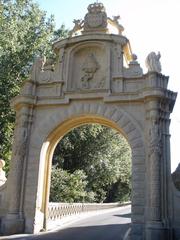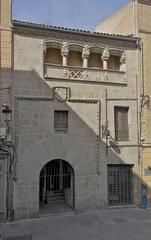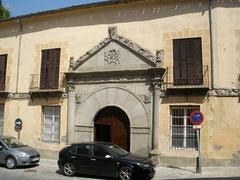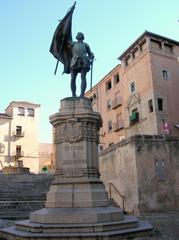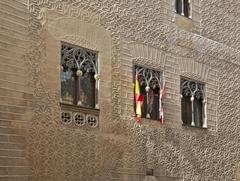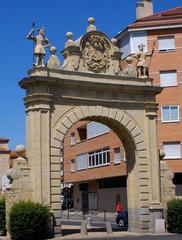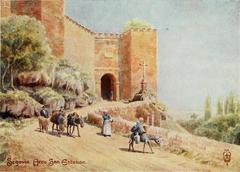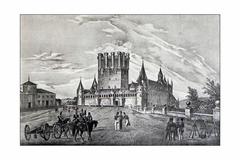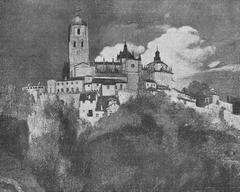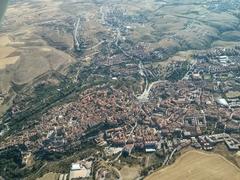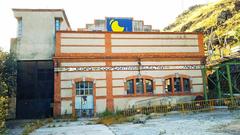
The Coining House Casa de la Moneda Segovia: Visiting Hours, Tickets, and Complete Guide
Date: 04/07/2025
Introduction
Situated on the banks of the Eresma River, the Real Casa de la Moneda in Segovia is a cornerstone of Spain’s industrial and numismatic heritage. Founded in the late 16th century under King Philip II and designed by the famed architect Juan de Herrera, this royal mint represents a crucial transition from manual to mechanized coin production, harnessing hydraulic power to revolutionize currency minting. Today, it stands as one of Europe’s oldest surviving mechanized mints and a must-visit site for those interested in history, technology, and architecture (Museo Casa de la Moneda, Spain.info, Turismo de Segovia).
This detailed guide provides everything you need to know for a rewarding visit—covering the history and significance of the site, ticket prices, opening hours, guided tours, accessibility, nearby attractions, and insider travel tips.
Historical Overview
Origins and Early Coinage in Segovia
Segovia’s minting history dates to around 20 BCE, with the earliest coins bearing the city’s name and marking its emergence as an economic center in Roman Hispania. These early coins were crafted by hand, a process limited in both scale and consistency (Patrimonio Activo CyL).
Foundation and Industrial Innovation
In 1583, King Philip II commissioned the construction of a new mint on the Eresma River, completed in 1588 by Juan de Herrera. This site was chosen to exploit the river’s hydraulic power—a revolutionary step that made the Segovia mint a pioneer in industrial-scale coin production in Europe (Spain.info).
Hydraulic Power and the Roller Press
The most significant technical leap was the introduction of the roller press, powered by waterwheels. This mechanized system, imported from Central Europe, replaced hammer striking and enabled the simultaneous production of multiple coins with unprecedented accuracy and volume. The hydraulic infrastructure, including preserved waterwheels and channels, remains a highlight for visitors (Patrimonio Activo CyL, Spain.info).
Evolution, Decline, and Preservation
Operating from 1586 to 1869, the mint continually updated its technology, expanding its influence to the Spanish colonies. The establishment of the School of Engraving in 1771 further cemented its artistic and technical importance (Museo Casa de la Moneda). After ceasing operations, the building survived periods of neglect and was restored in the early 21st century, reopening as a museum dedicated to industrial heritage.
Architectural and Industrial Significance
The Coining House exemplifies late Renaissance industrial architecture with its robust masonry, geometric layout, and practical design. Strategically located to harness river power, the building’s preservation—including its original stonework and reconstructed machinery—offers a rare glimpse into early modern industrial planning (turismodesegovia.com, worldheritagesite.org).
As one of Europe’s first and most complete mechanized factories, the Segovia mint is recognized for its outstanding universal value, despite being just outside the UNESCO World Heritage core zone (worldheritagesite.org). Its authentic setting, with views of the Alcázar and proximity to the Monastery of Santa María del Parral, enriches the visitor experience.
The Museum Today: Exhibitions and Visitor Experience
Permanent and Thematic Exhibitions
The museum explores the evolution of coin minting, featuring:
- Original and reconstructed hydraulic machinery, including operational waterwheels and presses
- Extensive numismatic collections, from early hammered coins to silver “pieces-of-eight”
- Interactive displays and multimedia presentations explaining the minting process and the connection between the mint and Segovia’s Roman aqueduct
- Rotating temporary exhibitions on related themes
Educational Value and Programs
Guided tours (in Spanish, with English available on request) and self-guided audio tours offer in-depth insights into the mint’s history and technology. The museum also hosts workshops and educational activities for all ages.
Facilities and Accessibility
- Accessibility: Ramps and elevators are available in most areas, though some historic sections may remain challenging for visitors with reduced mobility
- Amenities: Restrooms, a gift shop for souvenirs and books, and multilingual interpretive signage
- Photography: Permitted in most areas, but flash and tripods may be restricted
Visiting Information
Location and How to Get There
- Address: Calle de la Moneda, s/n, 40003 Segovia, Spain
- Access: A short walk from Segovia’s old town, Alcázar, and other historic sites; public transport and taxis are available, but parking is limited near the museum (Nomads Travel Guide, Makespain.com)
Opening Hours
- Winter (October–March): 10:00 AM – 6:00 PM
- Summer (April–September): 10:00 AM – 8:00 PM
- Closed: Mondays and select holidays; confirm hours on the official website before your visit
Tickets and Tours
- General Admission: €4–€6
- Reduced Admission: €3–€5 (students, seniors, children)
- Group Rates: Available with advance booking
- Purchase: At the entrance or online; pre-booking is recommended during peak season
- Guided Tours: Available in Spanish and, on request, in English; advance booking recommended
(Que Ver en Segovia, WhichMuseum)
Suggested Itineraries and Nearby Attractions
Enhance your visit by exploring:
- Alcázar de Segovia: Iconic castle, 7 minutes’ walk
- Monastery of Santa María del Parral: Tranquil monastic complex, 4 minutes’ walk
- Roman Aqueduct: UNESCO World Heritage site, 19 minutes’ walk
- Segovia Cathedral: Gothic masterpiece, 9 minutes’ walk
A typical itinerary might combine the Roman Aqueduct, Segovia Cathedral, a local lunch, the Alcázar, and the Coining House, finishing with a stroll along the Eresma River for scenic views and photography (The Crazy Tourist).
Practical Tips for Visitors
- Best Times: Weekday mornings or shoulder seasons (spring/autumn) for fewer crowds
- Dress: Comfortable shoes for walking and exploring multi-level spaces
- Language: Most signage is in Spanish; English tours and materials are available, but basic Spanish phrases are helpful
- Dining: Sample Segovia’s specialties nearby—cochinillo (roast suckling pig) is a local favorite
- Special Events: Check the museum’s calendar for demonstrations, workshops, and temporary exhibitions
- Photography: Late afternoon offers excellent natural light for exterior photos
Sustainability and Visitor Conduct
The museum is committed to sustainable heritage conservation. Visitors are encouraged to:
- Follow museum guidelines and signage
- Respect restricted areas and exhibit boundaries
- Dispose of waste responsibly
- Supervise children, especially near historic machinery and the river
Frequently Asked Questions (FAQs)
Q: What are the Real Casa de la Moneda Segovia visiting hours?
A: Typically 10:00 AM to 6:00 PM in winter, 10:00 AM to 8:00 PM in summer. Always check the official website for current hours.
Q: How much are tickets?
A: General admission is €4–€6, with discounts for students, seniors, children, and groups.
Q: Are guided tours available in English?
A: Tours are primarily in Spanish; English tours are available on request. Self-guided materials are multilingual.
Q: Is the museum accessible for visitors with reduced mobility?
A: Yes, most areas are accessible, though some historic sections may have limitations.
Q: Can I take photos inside?
A: Photography is allowed in most areas, but flash and tripods may be restricted.
Conclusion
A visit to the Real Casa de la Moneda Segovia offers a compelling exploration of Spain’s industrial and cultural evolution. From the ingenious use of river-powered machinery to its role in global coinage, the museum stands as a monument to innovation and craftsmanship. Plan your trip by confirming opening hours and ticket options, and consider pairing your visit with Segovia’s other architectural marvels for a truly enriching experience.
For more travel tips, detailed visitor information, and updates on cultural events, consult the official museum website and the Segovia tourism portal. Enhance your experience further with the Audiala app for guided tours and live audio commentary.
References and External Links
- Patrimonio Activo CyL
- Spain.info – Real Casa de Moneda Segovia
- Museo Casa de la Moneda
- Turismo de Segovia
- WorldHeritageSite.org – Segovia and Real Casa de Moneda
- Trek.zone – The Coining House Segovia
- WhichMuseum – The Coining House
- Que Ver en Segovia
- Adventure in You – Things to Do in Segovia
- Nomads Travel Guide
- Makespain.com
- The Crazy Tourist



